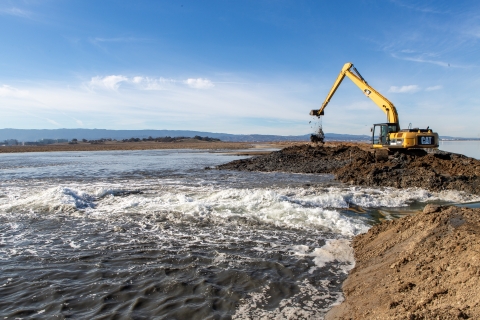Partners celebrate 20th anniversary of South Bay Salt Pond Restoration Project
On December 13, the South Bay Salt Pond Restoration Project partners and the U.S. Fish and Wildlife Service opened a 300-acre former industrial salt pond to the Bay with a celebration marking the 20th anniversary of their joint restoration venture. This major milestone event is part of an ambitious 50-year effort to restore 15,000 acres of historic wetlands to tidal marsh and other habitats.
Tidal marsh once ringed the South Bay and cushioned the shore from storms and tides. But over the course of the 20th century, approximately 85% of San Francisco Bay wetlands, over 150,000 acres, were lost to development. Restored tidal marshes help to absorb floodwaters and buffer against sea level rise, support wildlife and improve water quality by filtering pollutants.
“The restoration of the South Bay Salt Ponds is the most ambitious wetland restoration project on the West Coast,” said California State Coastal Conservancy Executive Officer Amy Hutzel. “It is thanks to the many people who have supported this project over two decades that we are able to breach the Ravenswood R4 pond today, opening hundreds of acres to the tides and currents of San Francisco Bay. The benefits of today’s breach will be felt by the wildlife that make their homes in tidal salt marshes, the adjacent communities that are now better protected from coastal flooding, and all of us who will get to watch this habitat come to life over the coming months and years.”
“Partnerships like the South Bay Salt Pond Restoration Project allow us to develop collaborative solutions and bring innovative initiatives into the future,” said Matt Brown, San Francisco Bay National Wildlife Refuge Complex Manager with the U.S. Fish and Wildlife Service. “The Don Edwards San Francisco Bay National Wildlife Refuge provides critical habitat to several endangered species, including the California clapper rail, salt marsh harvest mouse and western snowy plover. The restoration work here is protecting and restoring habitat for each of these species, which is significant not just for us today, but for future generations too.”
With this breach, the Restoration Project, the largest tidal wetland restoration project on the West Coast, has opened over 3,300 acres across the South Bay to allow nature to regrow tidal marshes, transforming former industrial salt ponds into a thriving mosaic of wetlands and creating habitat for endangered species and other wildlife. Restoration is working: since the project began, endangered salt marsh harvest mice and Ridgway’s rails have returned to early restoration sites to live and reproduce. Through the Restoration Project, partners have also enhanced 700 pond acres, built nearly seven miles of recreational trails, a kayak launch and several viewing and interpretive areas, and opened the shore to public access. A new public trail is expected to open at Ravenswood in 2024.
The South Bay Salt Ponds were acquired in 2003 from Cargill Inc. in a deal brokered by the late Senator Dianne Feinstein, a long-time champion of the restoration effort. The 15,100-acre property transfer represents the largest single […]
Full article: mavensnotebook.com

